Building a Brighter Tomorrow: Reconstruction of the Vivekananda Preschool in Kilinochchi District
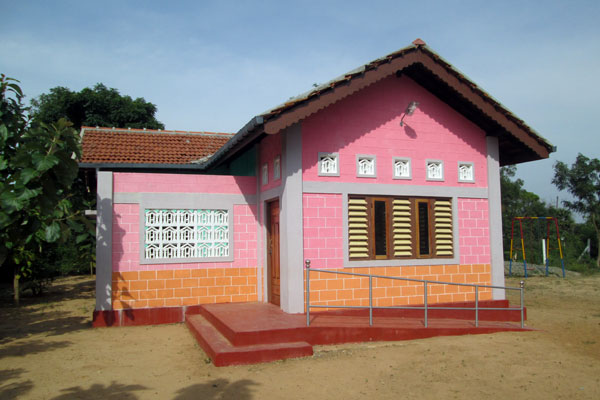
After: The newly constructed Vivekananda preschool.
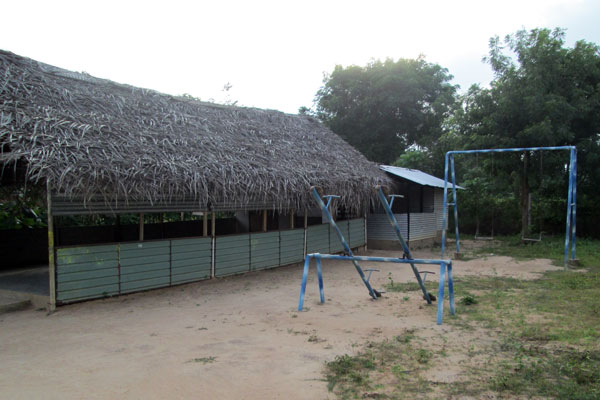
Before: The temporary structure that housed the Village preschool.
The “Improving Living Conditions in Returnee Areas of Sri Lanka through Housing” Project is a housing recovery initiative providing support to returning Internally Displaced Persons (IDPs) in the North and East of Sri Lanka. Funded primarily through a grant of € 11.8 million by the European Union (EU), donor partners include the Australian Government (DFAT) and the Swiss Agency for Development and Cooperation (SDC).
Jointly implemented by UN‐Habitat and SDC, the project provides cash grants and technical support to home owners to reconstruct and repair their conflict damaged houses. In addition to housing, the project also supports the reconstruction of essential community infrastructure facilities including community centres, internal roads, storm water drainage systems and preschools, to support resettled families to resume normal life. Overall, this project is supporting the reconstruction of 12 preschools in the Northern Province and one was recently constructed in Vivekanandanagar Grama Niladhari (GN) Division in Kilinochchi.
Vivekanandanagar, a GN Division with 465 residents, is situated in the Karachchi Divisional Secretary (DS) division of Kilinochchi district. This village, like many others, was affected by the prolonged conflict in the country. The conflict caused severe destruction to the assets and livelihoods of the residents. When the Project commenced activities in the village in 2013, a Settlement Improvement Planning (SIP) workshop was facilitated by UN-Habitat to assist residents to identify current gaps and priority infrastructure needs. Following detailed discussions, the residents collectively identified the construction of a preschool as one of their primary needs.
The three decades of conflict had resulted in negative impacts on children’s education in the Northern Province due to multiple displacements of the families and inadequate facilities in the villages. In addition to the lack of basic services such as housing, health care and education, many children had to contend with the loss of loved ones and many years of separation and displacement. Hence, the community were eager to establish a functional, early childhood development centre to ensure the welfare of their preschool aged children.
As the community were conflict affected and earned marginal incomes, they had no financial resources of their own to construct a new preschool building. Hence, the village preschool was housed in a temporary building constructed with tin sheets and cadjan, an inadequate environment for learning and providing poor protection from extreme weather conditions. This resulted in the reluctance of parents to send their children to the preschool causing a drop in attendance.
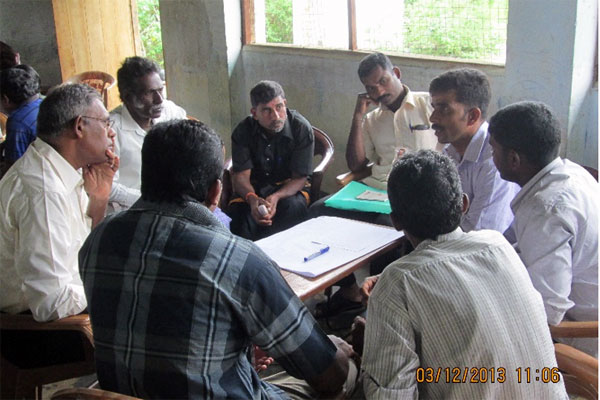
Progress review meeting with the members of the RDS and community
In keeping with the participatory “People’s Process” adopted by UN-Habitat and following a rigorous selection process, the construction of the preschool was handed over to a local community based organisation. The Vivekanandanagar West Rural Development Society (RDS) was selected to manage the construction process.
The construction work of the preschool commenced in November 2013. A total grant of LKR. 2,171,719 was provided in four instalments to the RDS based on physical progress of the work. Skilled construction workers were hired and the construction materials purchased by the RDS. Technical assistance was provided by UN-Habitat for construction activities including the architectural design of the preschool ( see Type Plan II for details), preparation of the bill of quantities, advice on building materials and procurement of skilled labour, along with special training on sustainable construction and disaster risk reduction methods for the RDS members and artisans. Community members have been actively involved in this intervention by participating in “shramadana” (voluntary clean up) campaigns to clear the area for construction and back-filling of soil for the foundation. The RDS successfully completed the construction of the preschool in August 2014, within a period of 10 months. The new preschool consists of a spacious “L” shaped class room, a kitchen to cook the children’s mid-day meals and a sanitary toilet. There is also a ramp to facilitate disability access and the toilets are also constructed with disability friendly features.
Environmentally friendly technologies have been incorporated into the construction. Fair-faced blockwork has been used to build the preschool walls with pre-cast concrete door and window frames used in place of timber frames. These measures have significantly reduced the cost of construction while contributing towards sustainability by reducing the number of trees felled for construction material. In addition, several construction best practices such as re-using construction debris and proper storage of building materials have been adopted by the RDS.
DRR features have been incorporated. The roof has been anchored securely to ensure resistance to high winds and the foundation level has been raised by 1.5 feet to withstand flooding during the monsoon rains. A concrete ring beam, constructed along the walls, provides structural bracing for the columns. A Rainwater harvesting tank has been installed on the preschool roof to collect and reuse water during the dry season.
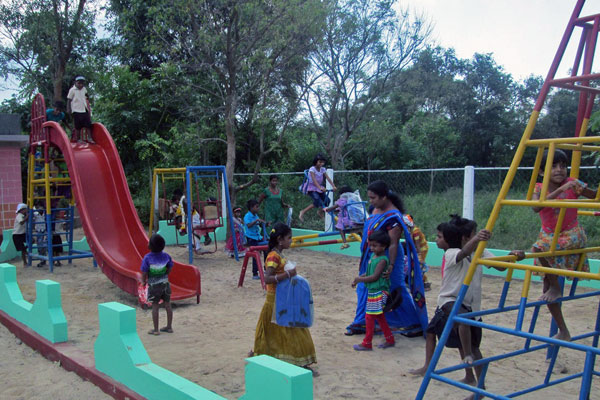
Children enjoying playtime in their new playground.
An outdoor playground has been established in the front yard with play equipment including swings, climbers and mat slides, to give the children an opportunity to play in a safe and clean environment.
The new preschool is now fully functional and has attracted several children from neighbouring villages due to its improved facilities and conducive learning environment. Children are showing great interest in their learning activities and the preschool teachers have noted a significant improvement in attendance. Speaking at the official handover ceremony of the preschool, the RDS secretary Mr. Sumuganathan stated “On behalf of our village, my sincere gratitude goes to the donors, the European Union, Government of Australia and SDC and to the UN-Habitat team for their assistance in constructing this preschool with all the necessary facilities. Since resettlement, for over four years, our village had no preschool. This preschool is not just a building. It has opened the door for a brighter future of our children.”
The “Improving Living Conditions in Returnee Areas of Sri Lanka through Housing” project was implemented from January 2013 to June 2015 in the districts of Killinochchi, Mullaitivu and Mannar in the North and Batticaloa in the East. The project supported the construction of 4,600 houses and a number of infrastructure initiatives including 12 preschools, 14 community centres, 17 wells and the rehabilitation of approximately 38 km of internal access roads.
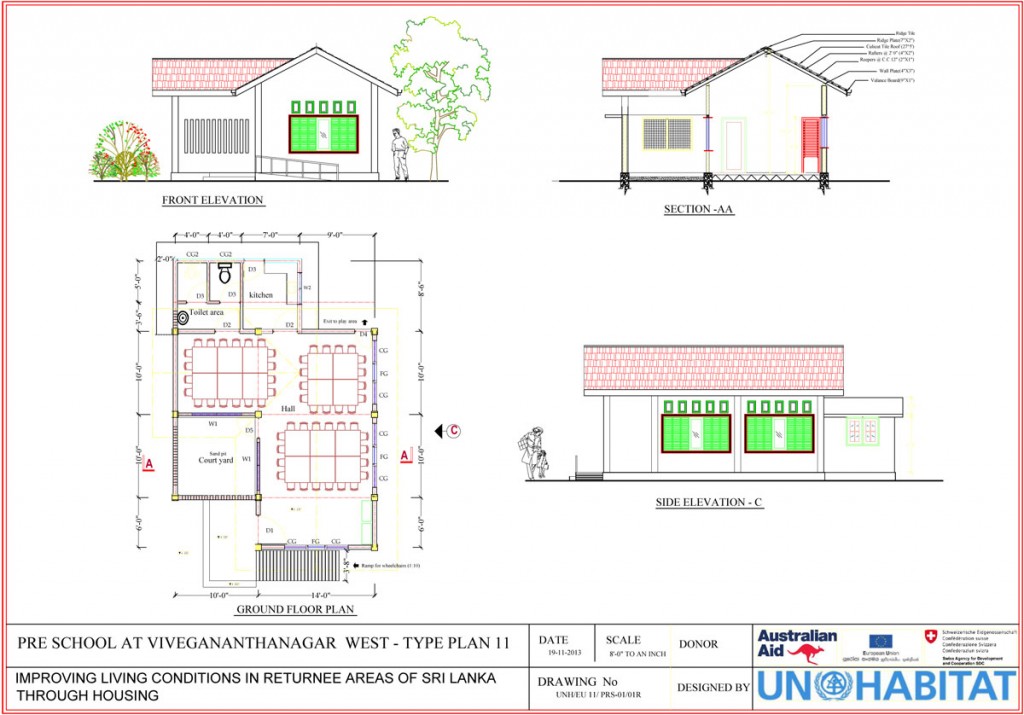
Type plan of the new Vivekananda Preschool
